Hydrangea
< Horticulture| Hydrangea | |
|---|---|
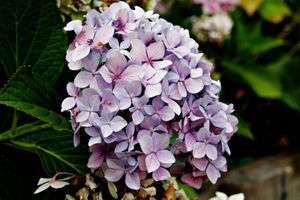 | |
| Genus: | Hydrangea |
| Family: | Hydrangeaceae |
| Type: | Trees, shrubs, and vines |
| Pest issues: | White-tailed deer are a serious issue |
| Pollination: | Insect |
Hydrangea (common names also Hydrangea, pronounced haidréindʒiə, and Hortensia) is a genus of about 70-75 species of flowering plants native to southern and eastern Asia (from Japan to China, the Himalaya and Indonesia) and North and South America. By far the greatest species diversity is in eastern Asia, notably China and Japan.
Species in the related genus Schizophragma, also in Hydrangeaceae, are also often known as hydrangeas. Schizophragma hydrangeoides and Hydrangea petiolaris are both commonly known as climbing hydrangeas.
Description
Most are shrubs 1-3 m tall, but some are small trees, and others lianas reaching up to 30 m by climbing up trees. They can be either deciduous or evergreen, though the widely cultivated temperate species are all deciduous.
Hydrangea flowers are produced from early spring to late autumn; they grow in flowerheads (corymbs or panicles) at the ends of the stems. In many species, the flowerheads contain two types of flowers, small fertile flowers in the middle of the flowerhead, and large, sterile bract-like flowers in a ring around the edge of each flowerhead. Other species have all the flowers fertile and of the same size.
In most species the flowers are white, but in some species (notably H. macrophylla), can be blue, red, pink, or purple. In these species the exact colour often depends on the pH of the soil; acidic soils produce blue flowers, neutral soils produce very pale cream petals, and alkaline soils results in pink or purple. Hydrangeas are one of very few plants that accumulate aluminium. Aluminium is released from acidic soils, and in some species, forms complexes in the hydrangea flower giving them their blue colour.
Species
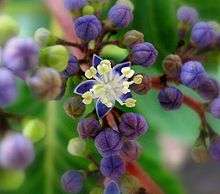
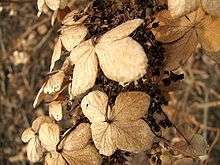
- Hydrangea anomala (Climbing Hydrangea). Himalaya, southwest China.
- Hydrangea arborescens (Smooth Hydrangea). Eastern North America.
- Hydrangea aspera. China, Himalaya.
- Hydrangea bretschneideri. China.
- Hydrangea candida. China.
- Hydrangea caudatifolia. China.
- Hydrangea chinensis. China.
- Hydrangea chungii. China.
- Hydrangea cinerea (Ashy Hydrangea). Eastern United States.
- Hydrangea coacta. China.
- Hydrangea coenobialis. China.
- Hydrangea davidii. China.
- Hydrangea dumicola. China.
- Hydrangea gracilis. China.
- Hydrangea heteromalla. Himalaya, west and north China.
- Hydrangea hirta. Japan.
- Hydrangea hypoglauca. China.
- Hydrangea integrifolia. China.
- Hydrangea involucrata. Japan, Taiwan.
- Hydrangea kawakamii. Taiwan.
- Hydrangea kwangsiensis. China.
- Hydrangea kwangtungensis. China.
- Hydrangea lingii. China.
- Hydrangea linkweiensis. China.
- Hydrangea longifolia. China.
- Hydrangea longipes. Western China.
- Horticulture/Hydrangea_macrocarpa. China.
- Hydrangea macrophylla (Bigleaf Hydrangea). Southern Japan.
- Hydrangea mangshanensis. China.
- Hydrangea paniculata (Panicled Hydrangea). Eastern China, Korea, Japan, Sakhalin.
- Hydrangea petiolaris (Climbing Hydrangea). Japan, Korea, Sakhalin.
- Hydrangea quercifolia (Oakleaf Hydrangea). Southeast United States.
- Hydrangea radiata (Silverleaf Hydrangea). Southeast United States.
- Hydrangea robusta. China, Himalaya.
- Hydrangea sargentiana. Western China.
- Hydrangea scandens. Southern Japan south to the Philippines.
- Hydrangea serrata. Japan, Korea.
- Hydrangea serratifolia. Chile, western Argentina.
- Hydrangea stenophylla. China.
- Hydrangea strigosa. China.
- Hydrangea stylosa. China.
- Hydrangea sungpanensis. China.
- Hydrangea xanthoneura. China.
- Hydrangea zhewanensis. China.
Uses
Hydrangeas are popular ornamental plants, grown for their large flowerheads, with Hydrangea macrophylla being by far the most widely grown with over 600 named cultivars, many selected to have only large sterile flowers in the flowerheads. Some are best pruned on an annual basis when the new leaf buds begin to appear. If not pruned regularly, the bush will become very 'leggy', growing upwards until the weight of the stems is greater than their strength, at which point the stems will sag down to the ground and possibly break. Other species only flower on 'old wood'. Thus new wood resulting from pruning will not produce flowers the following season.
Hydrangeas are moderately toxic if eaten, with all parts of the plant containing cyanogenic glycosides. However, poisoning in humans is rare, as the plant does not look like an enticing food source.
Maintenance
Deadwood tends to accumulate on most species, and needs to be pruned out. Pruning is best performed just after flowering in order to ensure new bud sets for the following year. The plants are frequently deadheaded as well after the flowers fade, but in some cases the flowers do provide some winter interest for the garden.
Propagation
Primarily propagated by cuttings, though some species freely self-seed.
Harvesting
Flowers can be harvested for use either as fresh or dried flowers. To dry, hang the stems upside-down until fully dry.
Pests and diseases
| Bacterial diseases | |
|---|---|
| Bacterial blight | Pseudomonas solanacearum |
| Bacterial leaf spot | Pseudomonas cichorii |
| Fungal diseases | |
|---|---|
| Bud and flower blight | Botrytis cinerea |
| Fungal leaf spots | Cercospora hydrangeae Corynespora cassicola |
| Powdery mildew | Erysiphe polygoni |
| Root rot | Pythium spp. |
| Rust | Pucciniastrum hydrangeae |
| Southern blight | Sclerotium rolfsii Athelia rolfsii [teleomorph] |
| Viral diseases | |
|---|---|
| Phyllody | Hydrangea ringspot virus |
| Ringspots | Hydrangea ringspot virus |
| Tobacco ringspot virus | Tomato spotted wilt virus |
- Melon Aphid: Aphis gossypii
- Crescent Marked Lily Aphid: Neomyzus circumflexus
Scales
- Oystershell Scale: Lepidosaphes ulmi
- Cottony Camellia Scale: Pulvinaria floccifera: (Chloropulvinaria floccifera)
- Cottony Hydrangea Scale: Pulvinaria hydrangeae
- Greenhouse Whitefly: Trialeurodes vaporariorum
- Giant Whitefly
- Silverleaf Whitefly: Bemisia argentifolii
- Citrus Mealybug
- Lygus Bug: Lygus lineolaris
- Fourlined Plant Bug: Poecilocapsis lineatus
- Boxelder Bug: Leptocoris trivittatus
- Rose Chafer Beetle: Macrodactylus subspinosus
- Japanese Beetle: Popillia japonica
- Leaf Tier: Exartema ferriferanum
- Two-spotted Spider Mite: Tetranychus urticae
Slugs and Snails
Gallery
-

A Hydrangea at Watermouth Castle, north Devon, England
-

Hydrangea flowerheads (closeup)
-
A Hydrangea painted by the botanical artist Redouté
-

Bigleaf Hydrangea
-

Bigleaf Hydrangea
-

Bigleaf Hydrangea
-
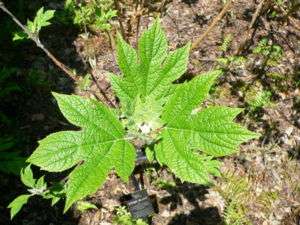
Oakleaf Hydrangea
-
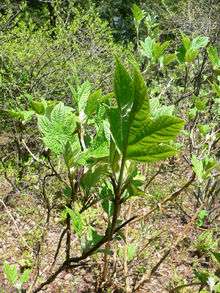
Oakleaf Hydrangea
References
- Flora of China: Hydrangea
- Flora of Nepal: Hydrangea species list
- USDA Plant Profile: Hydrangea
- Hydrangea arborescens images at bioimages.vanderbilt.edu
- Common Names of Diseases, The American Phytopathological Society
- Britton, Nathaniel Lord; Addison Brown (1913). An Illustrated Flora of the Northern United States and Canada, Volume 1 (second edition ed.). Dover Publications, inc.. pp. 230-231.
- Ann Fowler Rhoads and Timothy A. Block (2000). The Plants of Pennsylvania: An Illustrated Manual. Anna Anisko, illustrator. Morris Arboretum, University of Pennsylvania Press. pp. 455-456.
- P. D. Strausbaugh and Earl L. Core (1977). Flora of West Virginia (Second ed.). Seneca Books, Grantsville, W. Virginia. pp. 456-457.
- Christopher Brickell and Judith D. Zuk (1997). The American Horticultural Society A-Z Encyclopedia of Garden Plants. DK Publishing. pp. 538-540.
- Staff of the L. H. Bailey Hortorium (1976). Hortus Third: A Concise Dictionary of Plants Cultivated in the United States and Canada. Cornell University Press. pp. 578-579.
- Pirone, Pascal P. (1978). Diseases & Pests of Ornamental Plants (Fifth Edition ed.). John Wiley & Sons, New York. pp. 309-310.
- Cranshaw, Whitney (2004). Garden Insects of North America: The Ultimate Guide to Backyard Bugs. Princeton University Press. pp. 600.
- Pippa Greenwood, Andrew Halstead, A.R. Chase, Daniel Gilrein (2000). American Horticultural Society Pests & Diseases: The Complete Guide to Preventing, Identifying, and Treating Plant Problems (First Edition ed.). Dorling Kindersley (DK) Publishing, inc.. pp. 196.